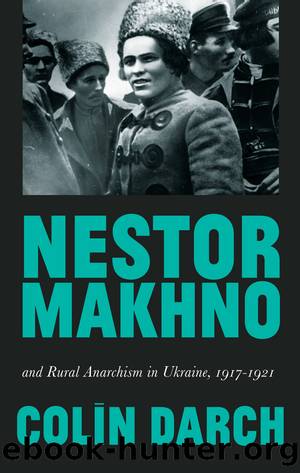Nestor Makhno and Rural Anarchism in Ukraine, 1917â21 by Colin Darch

Author:Colin Darch
Language: eng
Format: epub
Publisher: Pluto Press
The most important plank in this policy platform was the tax-in-kind, introduced in Russia in March and described by Lenin as marking âa transition ⦠to a regular socialist exchange of productsâ.138 Grain requisitioning was replaced by the tax in an attempt to win peasant support. After the government had taken 25 per cent of the crop, the peasants could dispose of the remainder as they pleased. Significantly, the tax was to be less than what had been taken by requisitioning; it was to be progressive; responsibility for payment was individual, not collective; and the amount was to be fixed before the spring sowing.139
But things were not so simple. On 2 March Vladimirov, the Ukrainian Commissar for Food Supply, reported to Moscow that working conditions were âsuch as to wreck all plansâ. Makhno had completely destroyed the food supply system in both Aleksandrovsk and Berdiansk, and had massacred food supply workers there.140 He was now doing the same around Kherson. He had crossed the Dnepr from Dneprovsk uezd, and had killed the district supply commissar as well as 42 workers from the Greater Aleksandrovsk food supply committee. From the Ukrainian point of view, continuing to supply the Donbass and the Red Army was an âalmost insoluble problemâ. Food requisitioning in the Ukraine had altogether cost the lives of 1,700 workers.141 Vladimirov was uneasy about the imminent change-over from grain requisitioning to the tax-in-kind, which he described as âdangerousâ. He argued that the peasants would contest the official crop assessments, acceptance of which was the basis for paying the tax and permitting the barter of the remaining crops.142 Despite these and other objections, the tax-in-kind was promulgated on 15 March 1921.143 Lenin commented to Trotsky that âthe Ukrainian communists are wrong. The conclusion is not against the tax, but for stronger measures for the total annihilation of Makhnoâ.144 Nevertheless, the introduction of the NEP in Ukraine was delayed by six months. While Vladimirov was complaining about the change of policy, the unit led by the deserter Maslak, which despite the need for mobility still possessed two field-guns, was moving north-eastwards towards the undefended town of Tsaritsyn, where 500,000 pudy (about 9,000 tons) of grain, the only reserves for Astrakhanâ, were stored.145
The Bolsheviks were also counting on the war weariness of the Ukrainian peasants to help them liquidate makhnovshchina. Different approaches were tried. The 5th All-Ukrainian Congress of Soviets offered an amnesty to all âbanditsâ who voluntarily turned themselves over to the authorities by 15 April, and later on the VTsIK extended the deadline. In April Plamia Truda reported some surrenders under the terms of this amnesty, including one allegedly involving 63 former insurgents in Guliaipole. On 1 June the same newspaper reported that some makhnovtsy insurgents had surrendered at Zmiev uezd, in Kharâkov, and had been given land.146
By March 1921, Makhnoâs situation had become desperate. His army was split up into marauding groups which carried out sabotage actions as they tried to survive by plundering military warehouses, or by battening onto the weary peasantry.
Download
This site does not store any files on its server. We only index and link to content provided by other sites. Please contact the content providers to delete copyright contents if any and email us, we'll remove relevant links or contents immediately.
I Have Something to Say by John Bowe(3466)
Einstein: His Life and Universe by Walter Isaacson(1967)
What Happened to You? by Oprah Winfrey(1730)
Doesn't Hurt to Ask by Trey Gowdy(1605)
Solutions and Other Problems by Allie Brosh(1298)
American Dreams by Unknown(1235)
Disloyal: A Memoir by Michael Cohen(1203)
The Silent Cry by Cathy Glass(1094)
Talk of the Ton by unknow(1018)
Infinite Circle by Bernie Glassman(1015)
Don't Call it a Cult by Sarah Berman(1009)
Group by Christie Tate(997)
Home for the Soul by Sara Bird(989)
Before & Laughter by Jimmy Carr(845)
Severed by John Gilmore(831)
Total F*cking Godhead by Corbin Reiff(823)
Ghosts by Dolly Alderton(819)
The Book of Hope by Jane Goodall(807)
Searching for Family and Traditions at the French Table by Carole Bumpus(786)
